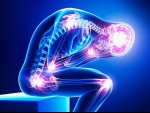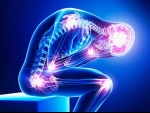Home »
Blog » Back Pain
| Stem Cell, PRP, Acupuncture in Queens & Long Island, New York
Back Pain | Stem Cell, PRP, Acupuncture in Queens & Long Island, New York
Tags: Back Pain | Posted on: 29-Sep-2021 | No of views: 6093 De-Stress: Standing Forward Bend - If you feel anxious or stressed, a quick time-out can help. Try this simple yoga move. Stand straight, legs together. As you breathe in, raise your arms high over your head. Bend forward at your hips as you breathe out, keeping your upper body aligned. Grasp your calves or ankles. Breathe deeply and hold about a minute. Breathe in and slowly come back up, head and arms lose and relaxed, to standing.
Read more
Tags: Back Pain | Posted on: 27-Sep-2021 | No of views: 6221 Like many of my own patients, you may be interested in doing more to treat pain than just relying on medications, but you aren’t sure where to start. One simple and accessible treatment to consider is something known as TENS, or transcutaneous electrical nerve stimulation. TENS is a handheld device that sends electrical impulses through small electrodes by adhesive pads attached to your skin. The pads are usually placed right on the part of your body that hurts. When the device is turned on, the electrical impulses flow into the skin and have the potential of decreasing different types of pain.
Read more
Tags: Back Pain | Posted on: 24-Sep-2021 | No of views: 9579 When a disc in your lower spine bulges or tears, you may feel pain in your lower back and/or your leg. Here are 3 unique signs of a herniated or protruding disc to help you identify the underlying cause of your lower back problem: 1. Pain While Sitting - An activity that exerts tremendous pressure on your lower spinal discs is sitting. If you have a herniated or bulging disc, this increase in pressure within your disc may cause the bulge to become more pronounced, which may aggravate your lower back pain when you sit.
Read more
Tags: Back Pain | Posted on: 20-Sep-2021 | No of views: 6092 Now that we are entering a new phase in the COVID-19 pandemic where access to vaccines is high, infection rates are declining, and there is greater access to health-related services, this might be a time to reevaluate your pain management plan and consider what changes can make a positive impact. Let’s start by taking a look at some of the ways the pandemic may have increased your pain problem:
Emotionally drained. Certainly, life during COVID-19 has been a source of intense stress.
Read more
Tags: Back Pain | Posted on: 15-Sep-2021 | No of views: 7430 Nonsteroidal anti-inflammatory drugs (NSAIDs) treat pain. They also relieve inflammation and reduce fevers. Over-the-counter NSAIDs include pills like aspirin, ibuprofen, and naproxen sodium, and creams you apply to your skin. Your doctor can also prescribe these pain relievers in a high-dose or more targeted version, like celecoxib (Celebrex) for arthritis.
Read more
Tags: Back Pain | Posted on: 10-Sep-2021 | No of views: 7308 If you have tried different types of office chairs and your back pain still persists, you may need to move on from the conventional seated-chair design to an alternate method. Here are 5 options to consider try a few out, to see which ones work best.
1. Standing Desk - A raised desk allows you to work while standing. Standing engages your core muscles more than sitting, and it can lead to better posture and spinal alignment. Switching between sitting and standing can also help manage chronic back pain.
Read more
Tags: Back Pain | Posted on: 08-Sep-2021 | No of views: 7242 Fibromyalgia - Fibromyalgia is a condition that makes your muscles ache and feel stiff. If you have it, you may be more sensitive to pain than most people. You’ll also feel the pain all over your body, on both sides and above and below your waist. You may have fatigue and brain fog, too.
Lyme Disease - In the first 3 to 30 days after you get a bite from a tick infected with Lyme disease, you may notice muscle and joint aches along with rash, swollen lymph nodes, fever, and chills. If you have these symptoms, see your doctor. Left untreated, Lyme disease can cause your joints to get stiffer and more painful over time.
Read more
Tags: Back Pain | Posted on: 06-Sep-2021 | No of views: 6794 A growing number of people are reporting lingering symptoms after overcoming their initial bout with COVID-19. "Long-haul COVID" refers to a condition where a person doesn’t feel fully recovered from their illness, even months later, after the infection has resolved. Initial reports indicate that one of the consequences of even milder COVID-19 infections can include persistent pain, including painful joints or muscles, splitting headaches, and chest pain.
Read more
Tags: Back Pain | Posted on: 30-Aug-2021 | No of views: 7060 If you find being in pain has left you feeling stressed, anxious, depressed, or a little grumpy, you aren’t alone. These emotions are very common among people living with ongoing pain. Pain can upend every aspect of our lives -- from how we move, sleep, think, feel, and interact with others to earning a living and doing the things that we love most. That can be an awful lot to deal with. A field of psychology called pain psychology can help.
Read more
Tags: Back Pain | Posted on: 27-Aug-2021 | No of views: 6509 Whether it's a herniated disc, spinal stenosis, or strained muscles, it can take some time to diagnose and treat the causes of back pain. And all the while, you're trying to navigate health insurance, work and family life, and everyday stressors in addition to your back pain.
1. Let Your Spine Really Rest While Sleeping - While you're lying down, all the structures in your spine that have worked hard all day finally have an opportunity to relax and be rejuvenated. To make the most of this time, you need a mattress and pillows that allow your spine to rest in a supported and comfortable way.
Read more
Love this Post? Spread the World






















